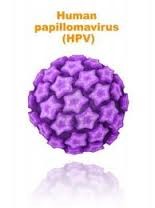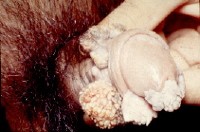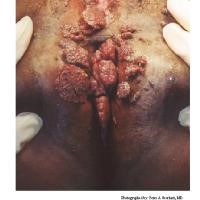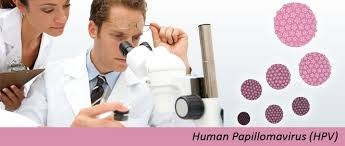Introduction
What is HPV?

HPV is short for human papillomavirus. There are many different types of HPV and of course, there are more than 100, in fact probably more than 200, HPV types out there. HPV is a different virus than HIV and HSV (herpes). The other thing we should know is, when we talk about papillomaviruses, we talk about warts. Nobody really cares about warts. We all got warts as kids; they all went away. The real reason that we talk about papillomaviruses is because of their association with cervical cancers, genital dysplasias, and genital cancers. But there are vaccines that can stop these health problems from happening.
Papillomaviru ses are non-enveloped viruses of icosahedral symmetry with 72 capsomeres that surround a genome containing double-stranded circular DNA with approximately 8000 base pairs.
ses are non-enveloped viruses of icosahedral symmetry with 72 capsomeres that surround a genome containing double-stranded circular DNA with approximately 8000 base pairs.
Papillomaviruses highly species-specific and do not infect other species, even under laboratory conditions. Humans are the only known reservoir for HPV, a virus that affects human skin and the moist membranes that line the body, such as the throat, mouth, feet, fingers, nails, anus and cervix. This virus tends to be much more stable in the environment. This is certainly why we get warts on our feet. In fact really all it takes to transmit the virus is contact between any 2 mucous membranes however we choose to bring 2 mucous membranes together, either directly or indirectly, perhaps on fingers, on mouths, and so on.
Clinical significance

What are the signs, symptoms and health consequences of HPV?
In most cases, HPV goes away on its own and does not cause any health problems. But when HPV does not go away, it can cause health problems like genital warts and cancer.
Does HPV really can cause cancer?
HPV can cause cervical and other cancers including cancer of the vulva, vagina, penis, or anus. It can also cause cancer in the back of the throat, including the base of the tongue and tonsils (called oropharyngeal cancer). Cancer often takes years, even decades, to develop after a person gets HPV. There is no way to know which people who have HPV will develop cancer or other health problems. For example, cervical cancer usually does not have symptoms until it is quite advanced, very serious and hard to treat. For this reason, it is important for women to get regular screening for cervical cancer. Screening tests can find early signs of disease so that problems can be treated early, before they ever turn into cancer.
The types of HPV that can cause cancers are not the same as the types of HPV that can cause genital warts.
Genital warts usually appear as a small bump or groups of bumps in the genital area. They can be small or large, raised or flat, or shaped like a cauliflower. A healthcare provider can usually diagnose warts by looking at the genital area.
People with weak immune systems (including individuals with HIV/AIDS) may be less able to fight off HPV and more likely to develop health problems from it.
Mode of transmission
How do people get HPV?
You can get HPV by having vaginal, anal, or oral sex with someone who has the virus. It is most commonly spread during vaginal or anal sex. HPV can be passed even when an infected person has no signs or symptoms. There’s no easy way to tell if someone is infected with HPV. HPV is the most common sexually transmitted infection (STI). Anyone who is sexually active can get HPV, even had sex with only one person. Symptoms will also develop years after having sex with someone who is infected making it hard to know when you first became infected. HPV is so common that nearly all sexually active men and women get it at some point in their lives.
Besides, a mother can transmit HPV to her baby during childbirth, but this is rare. When it occurs, the offspring’s upper respiratory system or genitals may become infected. Sharing of contaminated objects is a much less common way of transmission of HPV from one person to another. Although possible, finger-genital contact is a possible way of transmission, but not a major one.
Diagnosis
Many people have HPV infection without being noticed. HPV infection can disappear without causing problems. To detect HPV, doctors look for dysplasia or genital warts.
Dysplasia can be detected by a Pap test. The Pap test (Pap smear) is used to examine a woman’s cervix. This test can also be used to check the anus of men and women. Swab rubbed on the area being checked to pick up some cells. These cells smeared on glass and examined under a microscope. The cells are examined for abnormalities that may indicate abnormal cell changes. Some researchers believe that anal Pap tests and cervical cancer should be performed every year to people who are at higher risk.
Doctors can determine whether you have genital warts by seeing it. Types of HPV that cause genital warts are not the same as the type of virus that cause cancer. But if you have warts, you may have also infected with other HPV types that can cause cancer. Genital warts can appear anywhere from several weeks to several months after an infection with HPV. Warts may look like small bump, cauliflower-shaped, or flat lesions. They occur on the genital areas including the vagina, cervix, vulva, penis, scrotum, and anus. They are usually painless but they can bleed, itch, or have some discharge. Over time, the warts can be even greater.
 |
 |
 |
| HPV: “Cauliflower” condyloma of penis | HPV: Condyloma acuminatum in a patient | HPV: These condylomata extend to the anal verge |
Laboratory Diagnosis

The traditional methods of viral diagnosis such as certain immunological methods, and cell culture are not suitable for HPV detection. The important methods to diagnose HPV infection are:
- DNA test (PCR, Southern Blot Hybridization, In Situ Hybridization)
- Pap smear
DNA Test
This test detects whether high-risk HPV varieties are present; the ones that are associated with genital cancer risk. Some cells from the cervix are taken and sent to the lab for analysis. The established routine method for viral detection is the hybridization of viral nucleic acids.
PAP smear or PAP test
A sample of cervical cells or vaginal cells is collected and sent to the lab. This test can determine whether the cells have changed their structure (become abnormal). Abnormal cells usually means there is a higher risk of developing cancer. Apart from premalignant and malignant changes, viral infections like HPV infection and Herpes can also be detected.
Can HPV Infection Be Prevented?
How can I avoid HPV and the health problems it can cause?
Human papillomavirus (HPV) is a sexually transmitted virus that can affect men and women. There’s no easy way to tell if someone is infected with HPV. People who do not have any signs or symptoms of HPV infection can transmit the infection. Most of the time, HPV is harmless and goes away on its own. But it can cause genital warts and several types of cancer, including cervical and head and neck cancers. That’s why it’s important to protect yourself against HPV transmission. You can do several things to lower your chances of getting HPV:
- Get Vaccinated for HPV Prevention

The FDA has approved two vaccines (Cervarix and Gardasil) are safe and effective to protect males and females against diseases (including cancers) caused by HPV when given in the recommended age groups. HPV vaccines are given in three shots over six months; it is important to get all three doses. However the HPV vaccine does not protect against all types of HPV.
- Be Circumcised
Circumcision is the surgical removal of the foreskin, the tissue covering the head (glans) of the penis. It is an ancient practice that has its origin in religious rites. Today, many parents have their sons circumcised for religious or other reasons. Research shows that the risk of HPV in men is lowered when they are circumcised. The risk for infecting their female sexual partners is also lower. There are more than 50 subtypes of HPV that are associated with cervical, penile, and other cancers, such as head and neck cancers, so by protecting yourself and your partner from the spread of HPV, you could also be protecting both of you from some forms of cancer
- Get the Pap Test

The Pap smear is a test that checks for abnormalities in the cells that line the cervix and is one of the best ways to detect cervical cancer in its earliest stages. The Pap smear is usually done in conjunction with a pelvic exam. In general, doctors recommend beginning Pap smear testing at age 21 and then every two or three years. After age 30, Pap smears are generally recommended every three years, or every five years when the Pap smear is combined with an HPV test. This test can also be used to check the anus of men and women. If you have health concerns or think you might have HPV, talk to your doctor
- Limit Your Number of Partners

Another HPV prevention strategy is by being in a faithful relationship with only one partner, but even people with only one lifetime sex partner can get HPV. The more sexual partners you have, the more possible exposure you have to HPV. Some studies also suggest that knowing a new partner for eight months or longer before having sex can reduce your risk of HPV transmission. The risk is lowered because that time period allows any HPV infection that is present in the potential partner to clear.
- Use a Condom
Use latex condoms the right way every time you have sex. This can lower your chances of getting HPV. HPV is transmitted by skin-to-skin contact. Because HPV can infect areas that are not covered by the condom- so condoms may not give full protection against getting HPV, but condoms do help in HPV prevention. Also, never reuse a condom.
condoms the right way every time you have sex. This can lower your chances of getting HPV. HPV is transmitted by skin-to-skin contact. Because HPV can infect areas that are not covered by the condom- so condoms may not give full protection against getting HPV, but condoms do help in HPV prevention. Also, never reuse a condom.
- Don’t Have Sex Too Young

The younger you are when you start having sex, the greater your risk for HPV transmission. That’s because you’re more likely to come in contact with a partner who has HPV. If you know your partner’s history, you can make wiser choices for HPV prevention.
Prevention is always better than treatment
Summary/ Conclusion
There are over 100 different kinds of HPV and not all of them cause health problems; for sure till now no cure for the virus (HPV) itself. There is no routine screening test for HPV-associated diseases other than cervical cancer. The best thing you should do is – visit your doctor regularly for checkups!
References
- ACOG Announces New Pap Smear and Cancer Screening Guidelines. [Last updated on 2009 Nov 20, Last accessed on 2011 Mar14]. Available from: http://www.acog.org/acog_districts/dist_notice.cfm?recno=13andbulletin=3161
- Chuang TY, Brashear R. Genital Warts: Differential Diagnoses and Workup. [Last Updated on 2010 May 7, Last accessed on 2011 Mar 14]. Available from: http://emedicine.medscape.com/article/1133201-diagnosis.
- Garland SM, Tabrizi S. Methods for HPV Detection:Polymerase Chain Reaction Assays. Monsonego J. [Last accessed on 2011 Mar 14];In emerging issue on HPV infection. Available from: http://www.eurogin.com/EmergingIssues.pdf.
- Genital HPV Infection – Fact Sheet. Centers for Disease Control and Prevention (CDC) [Last updated on 2009 Nov 24, Last accessed on 2011 Mar 15]. Available from: http://www.cdc.gov/std/HPV/STDFact-HPV.htm.
- Human Papilloma Virus. [Last updated on 2011 Mar 9, Last accessed on 2011 Mar 13]. Available from: http://en.wikipedia.org/wiki/Human_papillomavirus.
- Morag C.Timbury, A. Christine McCartney, BishanThakker, Katherine N. Ward Notes on Medical Microbiology:Churchill Livingstone, 2002
- Martin CK, Richardson LC, Berkman ND, Kuo TM, Yuen AN, Benard VB. Impact of the 2002 American society for Colposcopy and Cervical Pathology guidelines on cervical cancer diagnosis in a geographically diverse population of commercially insured women, 1999-2004. J Low Genit Tract Dis. 2011;15:25–32. [PubMed]
- Mandelblatt JS, Lawrence WF, Womack SM, Jacobson D, Yi B, Hwang YT, et al. Benefits and costs of using HPV testing to screen for cervical cancer. JAMA. 2002;287:2372–81. [PubMed]
- Availablefrom: www.arhp.org/uploadDocs/HPV101PowerPointPresentation.ppt
- New Colposcopy Guidelines – what are the implications for the cytology services? [Last updated on 2005, Last accessed on 2011 Mar 13]. Available from: http://www.curran.pwp.blueyonder.co.uk/Colpo.htm.
- NHS Cervical Screening Programme. [Last accessed on 2011 Mar 13]. Available from: http://www.cancerscreening.nhs.uk/cervical/screening.html.
- Sweet RL, Gibbs RS. Human papilloma virus. Infectious Diseases of the Female Genital Tract. Chapter 6. [Last accessed on 2011 Mar 12]. Available from: ncbi.nlm.nih.gov/pmc/articles/PMC3139291
- Walboomers JM, Jacobs MV, Manos MM. Human papillomavirus is a necessary cause of invasive cervical cancer worldwide. J Pathol. 1999;189:12–9. [PubMed]
| Semakan Akhir | : | 3 March 2017 |
| Penulis | : | Hjh Ermie binti Abdul Hamid |
| Akreditor | : | Subki bin Ahmad |







